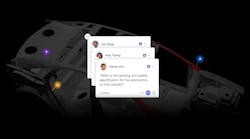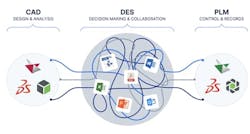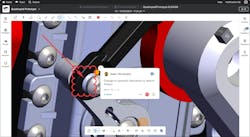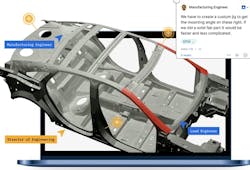Transforming the Design Review Process for Engineers in 2025
Why does anything have to change?
A manufacturing company’s most critical product decisions are made every day in design reviews. And if you assess the state of what a design review looks like today, manufacturing companies are in serious trouble.
A recent research survey of 250 engineering leaders reveals four key product development insights:
- 90% of companies delay product launches due to late-stage design changes.
- Engineering leaders rate design review quality as the No. 1 predictor of whether a project will be delivered on time.
- 43% of design review feedback is lost. Because engineering teams conduct design reviews in a disjointed workflow of several applications, feedback is either too difficult to surface or never documented at all.
- Most engineering leaders conclude that a better tool is needed to improve design review—as opposed to more meetings, better use of the tools at hand or better data management.
There’s an important story here.
Most companies delay product launches due to late-stage design changes. And it’s no wonder because, despite design review quality being the most important factor in getting a product to market on time, nearly half of all design feedback is lost and never actioned.
But why does this happen?
Because the tools and workflows engineering teams use to do design reviews are no longer appropriate for the complexity of today’s new product development. There are too many subject matter experts, too many complex assemblies and too many requirements for engineering teams to contend with.
And engineering leaders agree. Above all other strategies, they cite a better design review tool as the most effective strategy to improve design review quality.
The problem? There doesn’t seem to be a purpose-built tool to address this gap.
The stakes are too high for engineering teams to keep doing things the way they’ve always done them. Organizations cannot afford to risk lost revenue, product launch delays and quality issues any longer. To solve downstream product development issues, manufacturing companies need to find technology that enables immersive collaboration and leverages machine learning (ML) and artificial intelligence (AI) tools.
Doing anything less risks losing everything to their competitors who have already implemented these systems.
The Missing Piece to Comprehensive Collaboration
Product development and lifecycle management is not short on great technology at the beginning and end of the process. Engineers have computer-aided design (CAD) tools for product design and product lifecycle management (PLM) systems for product data and record-keeping. But between these systems—where people must interact with models and data together—there is a massive gap.
This is where a Design Engagement System (DES) comes in. A DES connects these two systems to enable collaboration, asynchronous engagement and a robust digital history of all review data so nothing is lost.
Unlike PLM alternatives, a DES does not seek to replace an existing PLM. Engineering organizations have already made large investments, both in money and time, to build PLM systems. So understandably, there is little desire to do away with these tools. Instead, the aim of DES is to extend the value of PLMs and CAD to enable engineers to review 30+ 2D and 3D CAD file types in a DES platform.
Why not just use the PLM for design review workflows? In the same study cited earlier, 71% of engineering leaders admit that their teams don’t use PLM at all during product development. This gap then is clear and must be filled by a single system rather than the hodgepodge of apps and workflows used by teams today. Because—as we saw in the survey results—this hodgepodge results in nearly half of all design review feedback lost or never documented.
How Design Engagement Systems (DES) Work
A DES is a purpose-built system that fills the gap between CAD and PLM systems during product development. The technology is designed to bring people into design conversations and product decision-making. It also acts as a force multiplier for PLMs while leveraging the metadata and visualization aspects of CAD.
This also means a DES should be integrated with the PLM the organization uses (for example, Teamcenter, 3DX or PTC Windchill), as well as the CAD platform (e.g., Creo, NX, CATIA, SolidWorks, CAD-neutral formats, etc.).
The engineer leading the design review can then push a file directly from PLM into the DES platform. Reviewers then open the file link in their web browser and assign it to one or many people to review. (Engineers can also upload CAD and other file formats directly from their desktops or laptops).
Then, when someone is assigned a task, that person receives an email and an in-app notification.
By clicking this notification, the team member is brought directly to the exact part of the design that requires their feedback. And because reviews are happening asynchronously and digitally, the engineer can review all previous team comments and see the review’s full context. For example, if an engineer marks up a model and assigns that markup to a team member, that team member receives a notification that takes them to this exact markup. They can then view that markup on the model and participate in any conversations.
All feedback in a DES is also self-documented, meaning every markup, comment and conversation is saved in a running issue management list, thus creating a complete history of the review automatically.
The format for a design review today is a lengthy meeting. And because teams are more globally dispersed, this means many engineers must travel or hold meetings at odd hours. As products have become increasingly complex, the number of people needed in these reviews has also increased, as specialists and external SMEs come into the process.
A DES enables everyone assigned to a design review to submit reviews remotely and with the full context of the assembly available. This helps engineering leaders address conflicting and duplicated feedback as everyone can see the feedback already given as they do their review. This also negates the need for an engineer to sort out feedback on different file versions in isolation. The owner can then implement changes directly in the DES, ask questions and submit another version until the team is fully aligned.
Engineering organizations that have already implemented a DES have successfully conducted thousands of reviews with zero unresolved issues. Take Mainspring Energy as an example. The company implemented a DES and saw a 50% reduction in total product development time, reduced BoM costs by 50% and released over 100 drawings to production with zero errors.
These results seem almost impossible, and it’s this skepticism that should highlight how important a DES is for product development teams. For another example, see “The Technology in Practice” section of this article.
A DES can also help engineering teams track and prioritize design review tasks across multiple reviews. This is essential as teams often conduct many reviews simultaneously during the course of a single NPD project. This can be done through a dashboard, which outlines all reviews, outstanding tasks and levels of urgency.
For instance, an engineering leader can look at the dashboard and identify a single design stuck in a review stage and see exactly which review is holding it up and who is assigned to it. Using existing processes, this task would take hours to days of messages and meetings to uncover. A DES puts that information at an engineer’s fingertips.
The process in a DES is very similar regardless of what is being designed, and organizations are already using the technology to design cars, medical devices, power generation technology and consumer electronics devices. But, when it comes to component design, the checklist feature is particularly useful. Engineers can build checklists geared toward specific components and use these as a guide during the review process.
How AI and ML can increase the benefits of DES
There are two substantial benefits to leveraging ML and AI tools in design reviews via a DES.
- Surfacing product data and lessons learned at the point of decision-making
- You’re prepping for a review, and a DES will show you lessons learned on past reviews of similar assemblies, parts, drawings and even documents.
- Enabling the automation of simple, repetitive tasks
- You can use AI to complete simple design checks.
Design reviews will always require a “human in the loop” approach; there’s no technology that can replace a skilled engineer. The point of AI should be to remove admin-intensive tasks so engineers can do more creative and innovative engineering.
Using ML and AI in this way can also enable direct comparisons between previous and existing reviews. This means engineers don’t need to waste time looking for information or even data that might not exist. A DES will surface these automatically, reducing the risk of repetitive mistakes.
Integrating AI into the design review process using a DES can also automate administrative work associated with tracking, sorting and prioritizing design comments or ideas. This frees up engineers for more value-add work and speeds up design review cycles.
DES technology is constantly evolving. Soon—potentially as soon as this year—tools that can introduce valuable downstream data into upstream design reviews, including warranty claims and scrap data, will be available. This innovation will reduce the likelihood of warranty claims and return material authorizations (RMAs). AI tools that can catch basic errors and incomplete procedures by using design review checklists and prompts created by engineers are also just around the corner.
Protecting IP
There is some nervousness within engineering organizations about the amount of data shared with a DES and the impact this has on intellectual property (IP). And this is only amplified when talking about AI—where organizations fear IP will be used to train public machine learning algorithms.
Caution is the right approach, and DES platforms must address and satisfy data security concerns to be adopted by engineering organizations and embedded into day-to-day operations.
This is done by default in a correctly applied DES. In using a DES you don’t transfer any IP; it’s shared in a viewer inside a Workspace owned by your company. This sharing is done via a website link that disables any downloading. Once the review is complete, you revoke access. Because the company owns the DES and owns the company data, their IP never goes outside the system.
Proper DES platforms also ensure permission models are robust and that they comply with key cybersecurity compliance frameworks (SOC 2) and international standards for information security frameworks (ISO 27001). The sign-on process includes single sign-on (SSO) and controls permissions so that only those required to access the product design review can get in.
When it comes to training AI models, a DES provider should reassure engineering organizations that the platform does not share or use other customer data to develop these models. Ultimately, a proper DES should show a robust approach to security and IP.
Fortune 500 manufacturing companies are already using DES platforms with confidence, which should send a strong signal to the market.
The Technology in Practice
This technology is not just an exciting thing to talk about; it’s being actively used in industry. Engineers, designers and other stakeholders are already creating tens of thousands of technical comments in DESs every year and they’re seeing the results.
For example, in the automotive industry, Ford Pro wanted to improve the way they collaborated with their network of converters in the design review stage. Converter partners are instrumental at this stage because commercial fleet partners maintain Ford’s competitive edge.
By using a DES platform, Ford Pro was able to bring hundreds of converter partners into 3D models years before these partners would have normally been brought in. Collating this feedback, Ford received hundreds of comments and model feedback reducing rework and warranty risk. Using a DES, Ford reduced time-to-market by 30%—an almost unheard-of increase in speed for the automotive industry.
With the ambition to be the “donor vehicle of choice,” DES technology enabled Ford Pro to deliver high-quality converter vehicles to commercial fleet operators more quickly. Perhaps unsurprisingly, the business is now rolling out the collaborative tool across more than 200 converter partners.
And it’s not just the automotive industry getting these results. Johnson Controls, the world's largest portfolio of building technology, software and services, discovered how a DES could support VA/VE (value analysis/value engineering) without getting whole teams across the global engineering and manufacturing organization together.
The DES platform gave Johnson Controls the ability to have various functional groups around the world reviewing and commenting on the exact same model, to include a broader range of people and perspectives and extend the timeframe engineers had to come up with ideas. By integrating DES into the design review process, Johnson Controls has doubled its VA/VE attainment rate.
Prepare to Adopt DES into the Product Design Review Process
As with all technology there are some challenges inherent to the adoption of DES, but these focus almost entirely around human and organizational behavior. Engineers who have lived through the incorporation and onboarding of CAD and PLM tools may hear the phrase “digital transformation” and feel immediately exhausted. That’s understandable.
One of the best things about a DES platform is that it has been built to integrate into existing systems and tools and augment the benefits of what is already there. As a browser-based cloud tool, there is nothing to download and engineers already using the technology find it intuitive and easy to use. Ultimately, it’s all about giving engineers the tools they need to bring the best products possible to market and, without DES, there’s a chunk missing.
For engineering leaders thinking about implementing a DES: Pick a department that has a reputation for innovation and openness to new technologies. If the technology is integrated into one team as a pilot, the results can be used as a case study to encourage other departments and the wider organization to engage. One engineering organization who onboarded the platform in this way saw a 500% growth rate in under six months as a result of user demand.
How do you know your organization is ready to adopt a DES into the product design review process? An easy way to find out is to ask engineering teams what the biggest pain point in product development currently is. For many, the answer is communication and collaboration during early-stage PD—and a DES solves this.
Machine Design accepts editorial submissions on how to solve specific design, engineering and technical problems. Submit your article query to [email protected].
About the Author

Adam Keating
Co-founder, CoLab
Adam Keating is a mechanical engineer and the co-founder of CoLab. He led development of one of the world’s first Hyperloop vehicles and invented an electric propulsion system for large-scale aircraft, among other achievements.




